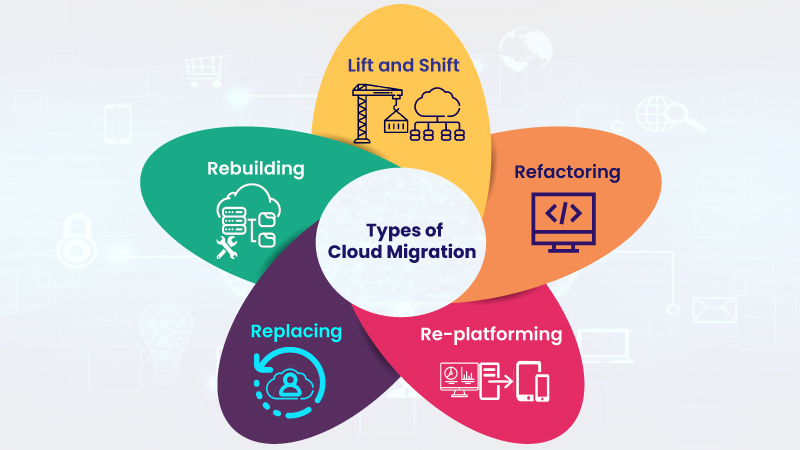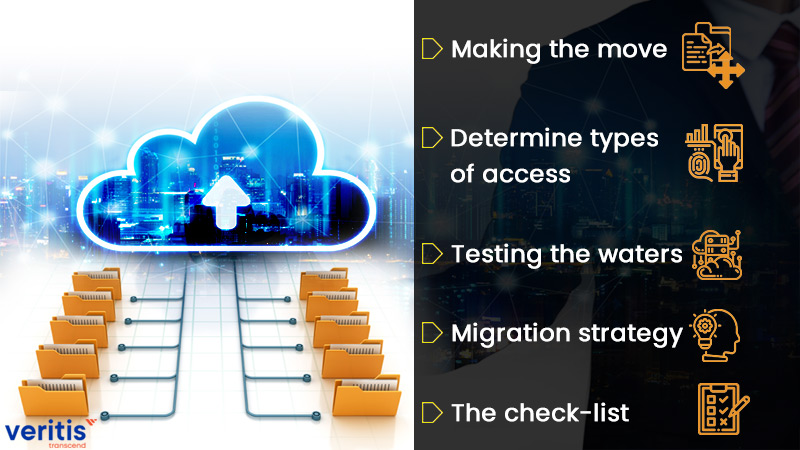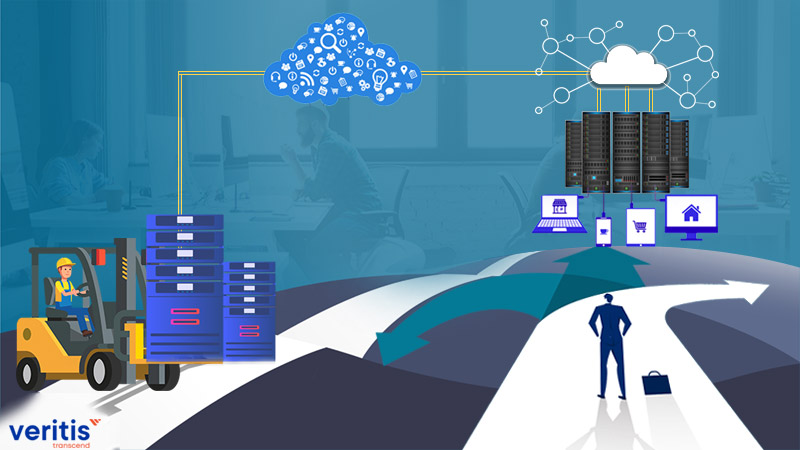Understanding Cloud Migration
With the global workspace’s digital revolution, Cloud has emerged as the priced alternative to on-premise physical servers. Organizations are gravitating towards hosting their applications and services on the cloud for high security and to function in terms of pay-per-use model and flexibility.
Cloud migration involves moving applications and data from an on-premise server to a cloud infrastructure. This transition from legacy infrastructure to a cloud platform could be either full or partial.
Types of Cloud Migration

- Lift and Shift– This approach is fruitful for migrating apps and their data to the cloud platform without modifying or redesigning the app. Organizations prefer to lift and shift model to sustain and protect their business and process workflows and data in the on-premises infrastructure. This model helps organizations take steps towards modernizing IT solutions and creating adaptable architecture on the Cloud.
- Rebuilding – In this model, an application code needs to be re-written to make it compatible with the cloud environment. However, if making the application compatible with Cloud or cloud-ready is too complicated, then the app is generally built from scratch.
- Replacing – This model comes into play when an application doesn’t comply with the cloud environment and cannot be rebuilt or modified architecturally. In this scenario, SaaS (Software as a Service) offers all the essential features of the application hosted minus the infrastructure overhead costs, development, or management processes.
- Re-platforming—This model is useful when the business application doesn’t entirely comply with the Cloud for architectural reasons or involves opting for the migration to facilitate app innovation and feature upgrades. In this scenario, the applications require few modifications or bare minimum code changes to ensure they make the best use of cloud infrastructure and are compatible.
- Refactoring—This model involves moving applications to the Cloud after the re-architecting process, which involves modifying software and rewriting a major portion of the code. It helps the applications become flexible and compatible with the cloud environment.
Since this process is complex compared to other cloud migration approaches, testing is needed to avoid functionality regressions. Despite the challenges involved, this migration offers the highest ROI.
Points to consider while choosing the Lift-and-Shift Cloud Migration Strategy

While planning for a cloud migration operation, there are a few points to consider before making the transition to Cloud:
- Making a move: The life span of the application and data should be more than 12 months, as a shorter period deems it unworthy of a move to the Cloud
- Determine types of access: Finalize the number and types of access required for operating the applications and accessing data. It is also essential to do any additional analysis to know how to offer access to data that is present in the code or data transitioned
- Testing the waters: While different cloud hosting providers would offer various automated tools for the migration process, it is crucial to examine them beforehand. It helps assess the capability of the tools as it is a great way to run a pilot/test migration and zero upon the architectural issues in the Cloud
- Migration strategy: Since organizations own numerous small applications and a variety of data, it is vital to amalgamate all the information at once for easy refactoring in the Cloud
- The checklist: Before setting up the cloud environment, it is essential to check the applications and data regarding regulatory requirements and compliance. Once migrated, regular validation testing should be initiated
When to employ the Lift-and-Shift Cloud-Migration Model?
The USP of the Life-and-Shift approach is that on-premises applications can be moved to the Cloud without redesigning. If you are facing a tight deadline and a budget constraint, then Life-and-Shift cloud migration could be the ideal solution. It is also an excellent choice for a first-time migration effort.
By adapting the lift and shift model, Down Jones could lower IT costs by 25%, and GE Oil & Gas could initiate 52% cost-savings.
Here are some instances where employing lift and shift would prove to be beneficial:
- If your organization is spending a fortune on on-premise infrastructure costs but is not in a position to rearchitect applications, then this model is a great choice. In such a scenario, the lift and shift model will give you a window to host the applications on the Cloud while preparing to rebuild or considering a transition
- If you are planning to migrate off-the-shelf applications, then the lift and shift is your best bet because they can’t be restructured and have to be moved as-is onto the Cloud
- If you need to opt for inexpensive and scalable backup and recovery, then transferring backups from on-premises hardware to the Cloud makes a great option
Challenges of a Lift and Shift Strategy

If you are contemplating adopting a lift and shift strategy for your data or applications, then here are a few points to consider:
- Takes more than a quick fix: While lift and shift migration might be a quick fix to eliminate the expensive costs of running on-premise hardware. By hosting Cloud applications, organizations can enjoy interruption-free services and avoid the costs incurred, usually rebuilding their applications or systems. However, this also implies that applications would not be optimized to avail of the benefits offered in a cloud environment
- Tweaks required: At some point, assets lifted and shifted into the cloud environment need rework for full advantage to attain cost-efficiency. While the apps need not be built from scratch, it needs tweaks to perform to their full extent. The advantage that the lift and shift model offers is that these changes can be made over some time without hindering regular business operations and eventually being able to reap all the benefits offered by Cloud
- Customized applications need that extra push: Though the lift and shift of commercial apps to the Cloud are considered manageable, it is no mean feat to move complex custom-built programs and cater to a specific requirement. These apps/programs might need multi-cloud deployment for complete operational efficiency and re-architecting as well
- Avoiding the Copy-and-Paste approach: The lift-and-shift model can be easily confused with a mere copy-and-paste job, leading to disastrous consequences. Instead, it needs an effort toward proper planning and migration testing before going live with the transition to Cloud
Advantages of the Lift and Shift Approach
Here’s what makes the lift and shift approach a favorite among organizations planning to move to the Cloud for the first time:
- It is touted as the fastest way to shift work systems and applications on the public cloud because there isn’t a need for code tweaks or optimization right away
- Considered the most cost-effective model, the lift and shift help save migration costs as there isn’t any need for configuration or code tweaks. In the long run, these savings could give away to extra spending if workload costs are not optimized
- With minimal planning required, the lift and shift model needs the least amount of resources and strategy
- Posing the least risk, the lift and shift model is a safe option as compared to refactoring applications, especially in the scenario where you don’t have code updating resources
Selecting the right Tools for lift and shift Migration
While creating a strategy for migration, it is essential to create a checklist of activities and a fair assessment of the tools and technologies employed for the process. A hassle-free lift and shift migration of applications must maintain minimum downtime, backup replication, and snapshot technologies.
All the leading cloud service providers offer cloud-native tools like Azure Database Migration and AWS Database Migration Service. Choosing the right tool would do more than lift and shift to the Cloud, ranging from data management capabilities like automated sync and data protection.
Reasons not to lift and Shift to the Cloud
While lift and shift might work well in many instances, it is also essential to understand when this model does not make sense:
1) Avoiding changes to applications
Since on-premise software architecture differs from cloud architecture, shifting legacy applications could prove cumbersome. There are bound to be numerous problems if you lift and shift a legacy application directly into the Cloud without program architecture. The program might become slug and unresponsive and run inefficiently while pulling additional resources to increase costs.
2) Not up for restructuring the IT department
Transitioning from legacy applications to a cloud environment is an ideal opportunity to rethink or define the IT personnel’s role in an organization. Traditional IT teams work in silos, with few involved in the development aspect while others work on day-to-day operations.
Through organizational cloud migration, these barriers can be broken down. But these changes would not amount to anything if the lift and shift strategy did not tap into the Cloud’s potential. If the IT teams are trained to implement hybrid Cloud or complex cloud-based solutions but end up only moving legacy applications to the Cloud, there could be disappointment.
Hence, an organization should move to Cloud only when it is prepared to rethink its approach to IT practices.
Steps involved in a smooth transition to Cloud

Here are some steps to consider while making the transition to the cloud via lift and shift strategy:
- Choose the platform meant for migration
- Assess all the applications and the data stored
- In case of more than one application lift and shift, multiple migrations need to be considered
- Opt for containerization to recreate current software configurations, which help to test the Cloud before going live
- Create a backup of various databases from the current systems and file
- Test the application post-migration process
- Run a check to ensure various data compliance and regulatory measures are met in the new cloud environment
- Refrain from introducing new features while migrating, as it could lead to hours of additional testing
- Once testing is done, stop the old system
Conclusion
At Veritis, we offer Cloud migration services in the Northern American region. We help our clients enable the right decision-making and maximize their ROI despite the changing digital landscape.
More Articles:

